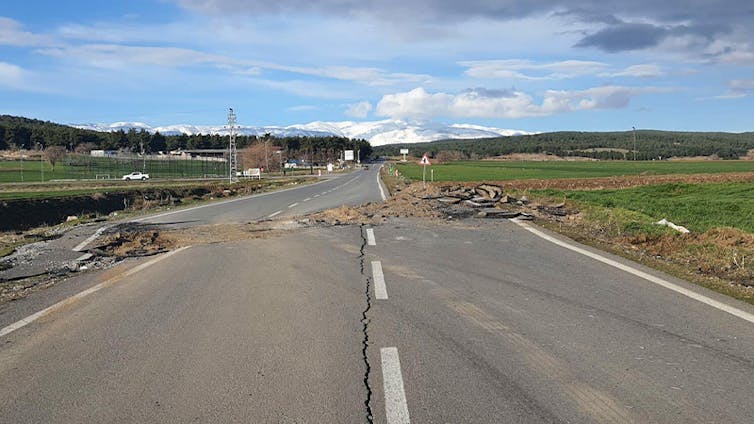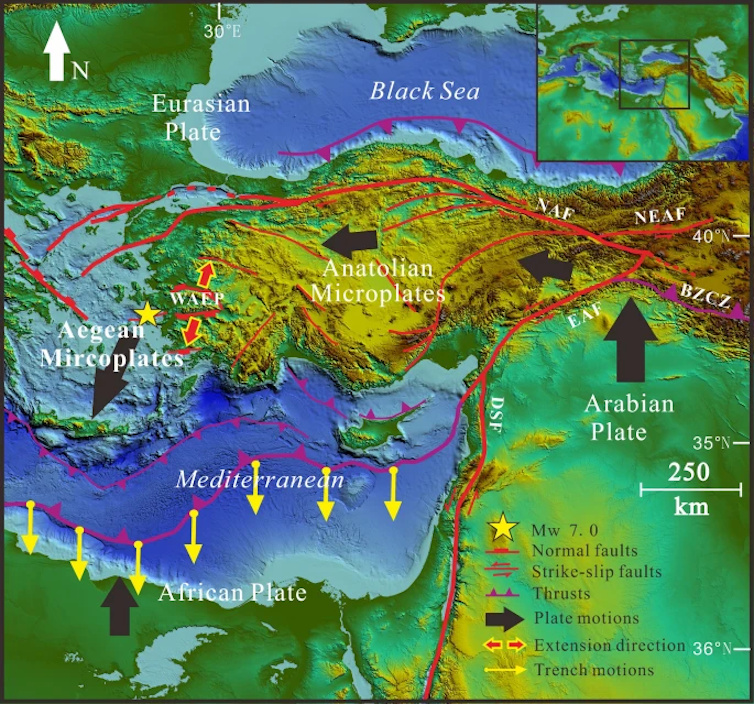The earthquakes that struck in Turkey and Syria in the early hours of February 6 have led to terrible destruction on a scale not seen in Europe for many decades. At the time of writing, the death toll has risen beyond 11,000 people and will continue to rise over the coming days and weeks. Hundreds of thousands more have lost their homes.
There are many reasons why the death and devastation have been so terrible. First and foremost, the sheer magnitude of the two main events and their associated aftershocks. These earthquakes, which measured 7.8 and 7.5 on the moment magnitude scale, each released roughly as much energy as the largest-ever atomic bomb test carried out during the Cold War – around 50 megatons, in 1961 by the former Soviet Union. And there were two of these events in the same region, separated by a matter of hours.
To this we have to add the clusters of aftershocks which follow on from the main events. These are smaller (mostly lower than magnitude 5) but will continue for several days, gradually decreasing in intensity and regularity. They are nevertheless dangerous, as buildings already seriously weakened by earlier events may be caused to collapse. This inevitably further hampers rescue attempts in the region.
Another factor is the timing of the first and largest earthquake. It occurred at 4.17am local time, when most people would have been asleep in their homes. During an earthquake, the great majority of casualties are caused not by the shaking, but by the resulting collapse of buildings. The timing of this event was about as bad as it possibly could be – many people had very little opportunity to escape from their homes in time. This is likely a major factor in the very high number of deaths and injuries.
Depth charge
But a key geological contribution to the devastation was the relatively shallow depth of the earthquake hypocentres: 18km for the first 7.8 event and 10km for the later 7.5 shock.
The hypocentre is the point at which the fault begins to rupture at depth. In global terms, these are relatively near-surface shocks. There are two reasons why this leads to a greater degree of destruction.
Put simply, the first reason is that the shallower an earthquake is, the closer the Earth’s surface is to the hypocentre. This means that the ground shaking is more intense and destructive. There is less opportunity for the shockwaves to dissipate, as happens when earthquakes occur deeper in the Earth and they travel through tens of kilometres of rock.
The second reason is that the faults that generate earthquakes larger than 5.5 are more likely to rupture through to the surface. This creates – almost instantaneously – a ground displacement whereby one part of the ground literally moves by several metres relative to an adjacent part.
These surface breaks – also known as “capable faults” – are incredibly damaging. They can lead to the severing of major subsurface and surface infrastructure including water mains, electricity cables, gas pipelines and tunnels.
There are already reports of damage to pipelines in Turkey following the February 6 events. Spectacular satellite images and ground-based photographs are also emerging of offset roads and railway lines, as well as serious damage to buildings that straddle the ruptures. All of this occurs in addition to the damage caused by shaking, liquefaction of soft sediment in valleys, and landslides.

In a recent blog, Professor Hasan Sözbilir of the Dokuz Eylül University Earthquake Application and Research Centre has studied the region and reported: “As far as I can see, at least three fault segments have been broken. The total length of the surface fracture has exceeded 500km.”
So why were these events relatively shallow in this region? Some of the largest earthquakes known to have occurred are associated with the so-called “Pacific Ring of Fire”. These earthquakes are commonly generated as deep as 700km, as the strong, dense oceanic plates plunge down into the Earth below the surrounding continents.
Turkey, however, lies in a region of weaker, mainly continental lithosphere where the crust is only about 30 km thick, close to a point where three tectonic plates come together – Africa, Arabia and Anatolia. The convergence of the Arabian plate is squeezing the wedge-like Anatolian plate out to the west, generating a series of sub-vertical, strike-slip faults such as the East Anatolian Fault, which failed during the magnitude 7.8 event.

In such continental crust, the strongest part – and the most likely point for large earthquakes to be born – lies typically at between 10km and 20km depth. In settings of this kind, shallow, surface-rupturing faults are more likely to form.
Wrong time, wrong place
A third factor is simply that the region where the earthquakes occurred is highly populated. Given the timing, a substantial loss of life is almost inevitable following an event – or events – of this magnitude.
Deadly earthquakes are well known in Turkey. In the past 50 years, there have been at least four major events with substantial loss of life – in 1975, 1983, 1999 and 2020. Following the Izmit earthquake in 1999, there were serious efforts by the Turkish authorities to improve building standards to better resist earthquakes.
But there are limits as to what you can do in a highly populated area with events of this size. And we have to remember that the two main seismic shocks were perhaps more than twice as big as the largest known historical earthquake in this region.
Furthermore, in Syria we have to add the fact that years of ongoing civil conflict have substantially degraded the building infrastructure, making the region event less resilient to the effects of seismic shaking. This will likely also hamper efforts to deliver assistance and aid – and, in the longer term, to rebuild.![]()
Bob Holdsworth, Professor of Structural Geology, Durham University
This article is republished from The Conversation under a Creative Commons license. Read the original article.


